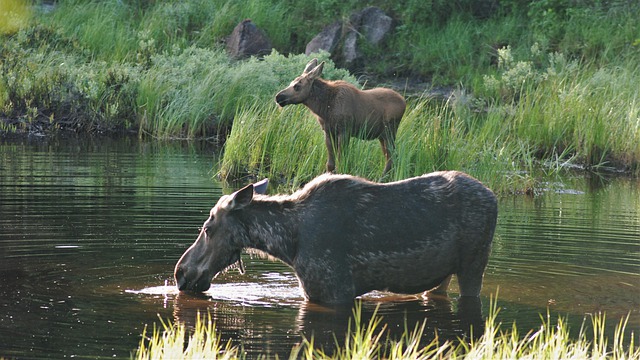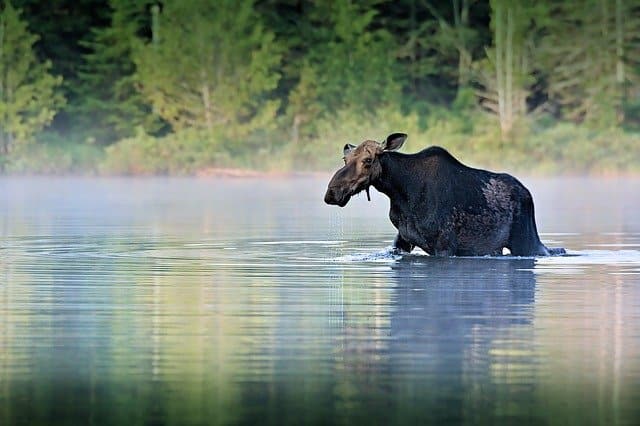The moose (Alces alces) is a massively large member of the deer family that lives in the colder, northern climates. In North America, moose are found primarily in the forests of Canada and Alaska, with Maine having the largest grouping of the lower 48 states.
They’re a distinctive deer subspecies and are amongst the largest land mammals in the world. In fact, they are the tallest mammals in North America, reaching a height of up to 7 feet.
In Europe and Asia, moose are commonly known as “elk.” Moose species are found in the cold, forest regions there, as well. When the British arrived in the Americas, they mistakenly referred to the Wapiti Deer as “elk,” and the name stuck. Moose is specifically an American English term.
What Size are Moose?
Table of Contents
Toggle- Head & Body Length – 6 to 10 feet
- Shoulder Height – 5 to 7 feet
- Tail Length – 2.75 to 6 inches
- Weight – 550 to 1800 lbs.
What do Moose Look Like?
The moose is the largest species of deer. It has a distinctive and easily recognizable appearance, unlike that of any other species of deer.
Its stature is instantly recognizable, with its humped back, long thin legs, and large bulky head.

Its body is short in length but large and bulky. The moose has a front-heavy appearance with large and well-developed shoulders.
Males and females have similar appearances, though males are larger and stockier than females.
Coat and Color
The coat is thick and coarse in texture. Most have a dark brown coat that is a uniform color across the body.
The coat is short, except around the shoulders where longer fur forms a distinctive mane. This mane further emphasizes the size of the front part of the body.
Face, Head & Antlers
Moose have a large overhanging lip, which they use during feeding to grab at tufts of vegetation. The tail is extremely short and often not even visible.
Moose are extremely sensitive to sounds and smells. The ears are large and oval-shaped, and they quickly prick up when they hear something. Sight is less important, and their eyes are comparatively small in size.

Moose have the largest and heaviest antlers of any deer.
Only males have antlers. Antlers can grow up to 6 feet long, and weigh up to 80 pounds. They grow horizontally from the head and point slightly backward. They have a broad palmate or “open-hand” shape. However, some moose grow antlers that aren’t broad and more like the antlers seen in other deer species.
The size of the antlers depends on the area in which the moose lives, and the physical condition of the animal. Older more mature males have the largest antlers. The antlers fall off each year between December and March, and a new set begins to grow in April. The antlers are fully-grown and ready for use by August.
Alces alces Subspecies of Note
The American subspecies are the Rocky Mountain Moose (A.a.shirasi), the Western Moose (A.a.andersoni), the Eastern Moose (A.a.americanus), and the Alaskan Moose (A.a.gigas).
The European and Asian subspecies are the European Elk (A.a. alces), The extinct Caucasian Elk (A.a.caucasius), the East Siberian Elk (A.a.pfizenmayeri), the Ussuri Elk (A.a.cameloides), and the Kamtschatka Elk (A.a. buturlini).
In Europe and Asia, the Moose is commonly known as the Elk.
Where do Moose Live?

Distribution & Range
Moose live in the northern forest areas of Asia, Europe, and North America.
They have a large distribution, ranging from Eastern Europe and Scandinavia, across temperate Asia into Siberia.
In North America, they live in Canada, as well as Alaska, Maine, and the Pacific Northwest of the United States.
In Europe, they are expanding their range westwards, because hunting pressure has been reduced.
Preferred Habitat
Moose are primarily forest animals. They are most often seen around woodland glades and clearings, or along forest streams and rivers. They also occur in more open habitats, like moorland and marshland.

In the summer months they move away from the forest and onto the tundra plains.
What do Moose Eat?
Because of their large size, moose eat a lage amount of food each day in order to fulfill their energy needs. It is estimated that they must eat about 90 lbs. each day. They spend a considerable amount of time searching for and grazing on food.
They eat a variety of green material, including leaves, mosses, ferns, grasses, herbaceous plants, and twigs.
How Long do Moose Live?
In the wild, moose have an average lifespan of between 8 and 12 years.
Mating Habits & Reproduction
Now let’s take a closer look at the mating habits and reproduction cycle in Alces alces.
How Moose Mate and Breed
Moose are polygamous. Males mate with multiple females during the breeding or rutting season.
The rutting season occurs between September and November, depending on the location. Females go into heat for 2 to 5 days long at a time. If the female is not successfully mated during this time, she will go into heat again about 3 weeks later.
The main problem moose have during the rut is finding mating partners. Moose are usually well spread out. When the female goes into heat she emits a loud bellow to attract males to her. When a male arrives, it will mate with the female and remain with her until she is not receptive anymore.

Confrontations During the Rut
Often two or more males will come together to a single female. In these cases, males compete and the dominant male mates with the female. Often one of the males will know it is not the most dominant and retreat.
Sometimes if the males feel they are evenly matched, they will fight over the female. The males may then lock antlers and take part in a pushing contest, the winner successfully pushes his opponent away. When the female is no longer receptive the male leaves to find other females. Males may mate with several females during the rutting season.
How Moose Give Birth to Their Calves
Calves are born in April or May after a gestation period of about 220 to 240 days long. Usually a single calf is born. Up to 4 may be born, although this is uncommon.

At birth, the calves weigh between 15 and 36 lbs. They are a reddish-brown color. This reddish coat fades into the more adult darker brown after about 4 months. Young moose will start to eat greenery and plants within a few days of being born. They are not totally weaned until they are at least 4 months of age.
The females are usually sexually mature at 2 years of age. Males mature at a similar rate. They are rarely large and strong enough to mate until they are 4 to 5 years old.
Interesting and Notable Behavior
Moose are mostly solitary in behaviour and only coming together for rutting in the fall. Females, however, are often accompanied by their young.

Moose typically don’t display territorial behavior. They live in large home ranges. The boundaries of these often overlap with those of other moose. They do not defend their home ranges in any way. If two animals meet, they will normally ignore one another and soon move apart.
Moose are mostly sedentary and don’t move large distances. The only exception to this is during the rut, when males may move large distances to search for females.
In summer, moose may move around their home range in search of food. During the winter months when there is little food to be found, they will find a sheltered location and spend much of the winter there.
Moose are mostly active during the early hours of the morning and in the late afternoons. During the middle part of the day they rest.

They are excellent swimmers and live happily in marshy and wet areas. Their broad feet allow them to move easily through boggy terrain.


